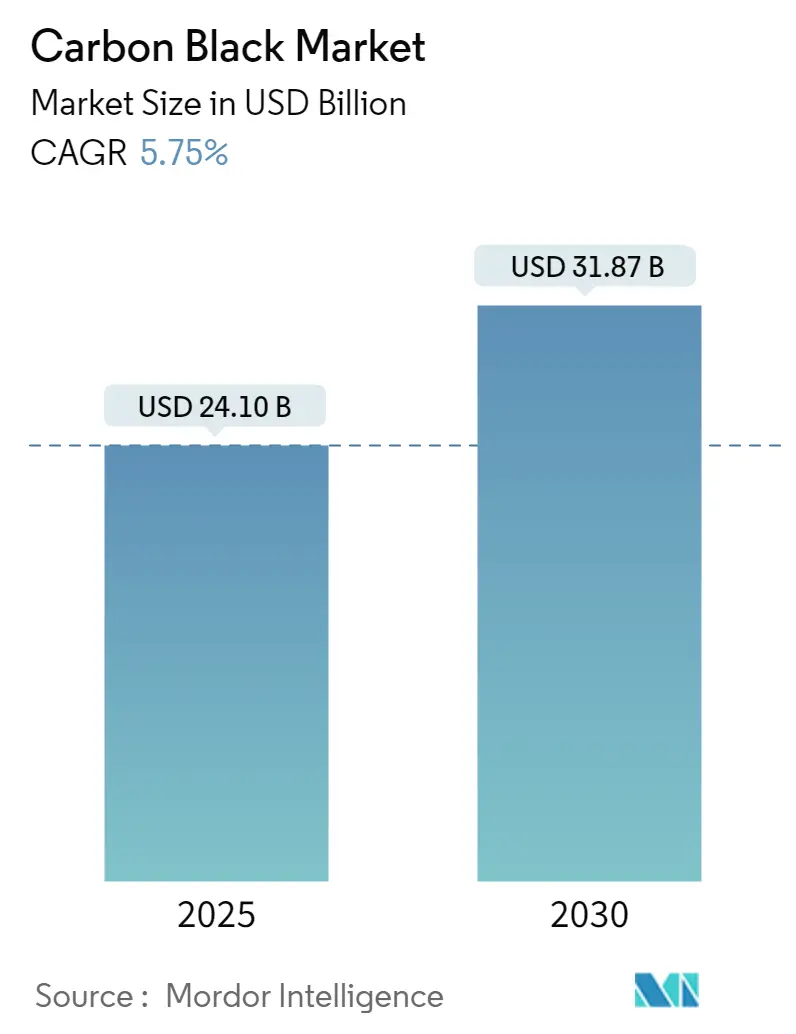
| Study Period | 2019 - 2030 |
| Market Size (2025) | USD 24.10 Billion |
| Market Size (2030) | USD 31.87 Billion |
| CAGR (2025 - 2030) | 5.75 % |
| Fastest Growing Market | Asia-Pacific |
| Largest Market | Asia Pacific |
| Market Concentration | High |
Major Players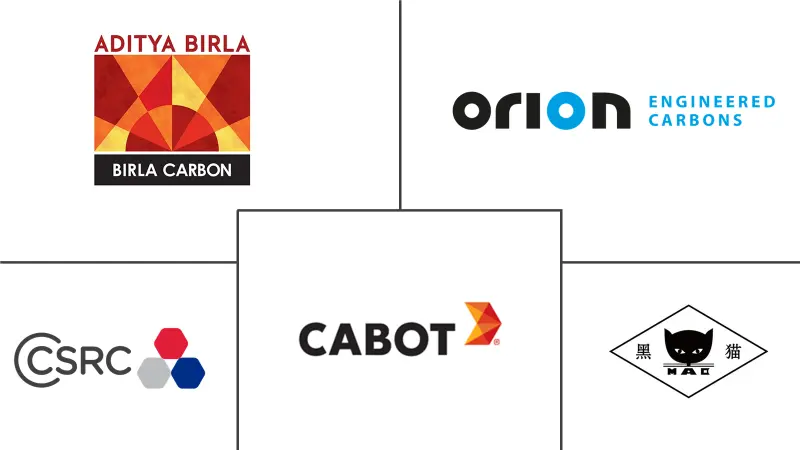
*Disclaimer: Major Players sorted in no particular order |
Carbon Black Market Analysis
The Carbon Black Market size is estimated at USD 24.10 billion in 2025, and is expected to reach USD 31.87 billion by 2030, at a CAGR of 5.75% during the forecast period (2025-2030).
The carbon black industry is experiencing significant transformation driven by evolving automotive and manufacturing sectors. Vehicle production has shown remarkable recovery, with European production reaching over 9 million units in the first three quarters of 2023, marking a 14% increase compared to the previous year. This surge in automotive manufacturing has directly influenced the demand for carbon black, particularly in tire manufacturing and automotive components. The industry is also witnessing substantial investments in production capacity expansion, with several manufacturers implementing strategic initiatives to meet growing demand across various applications.
The plastics and polymer sector has emerged as a crucial growth driver for the carbon black market, with increasing applications in engineering plastics, films, and specialty products. China continues to dominate the global plastics industry, accounting for 32% of global plastic production in 2022, equivalent to 128 million tons. Major carbon black companies are responding to this demand through strategic expansions, exemplified by PCBL's commissioning of its first phase specialty black expansion at Mundra, Gujarat in July 2023, adding 20,000 MTPA capacity to meet growing market requirements.
The electric vehicle revolution is creating new opportunities for carbon black manufacturers, particularly in battery and specialized component applications. Global electric vehicle sales demonstrated remarkable growth with over 2.3 million units sold in Q1 2023, representing a 25% increase compared to the same period in the previous year. This trend is further supported by significant investments in the sector, including Tesla's announced USD 30 billion investment plans in India in January 2024, indicating strong future demand for carbon black in EV-related applications.
The industry is witnessing significant technological advancements and strategic consolidations aimed at enhancing product capabilities and market reach. Notable developments include Birla Carbon's strategic acquisition of Nanocyl SA in October 2023, strengthening its position in battery materials for lithium-ion batteries. Additionally, Transform Materials' agreement with Denka in November 2023 for researching emission-free production of acetylene black, supported by a USD 19.9 million government subsidy, demonstrates the industry's commitment to sustainable innovation and environmental responsibility.
Carbon Black Market Trends
Increasing Market Penetration of Specialty Black
Specialty carbon black, also known as pigment black, is witnessing significant market penetration due to its superior properties and expanding applications across industries. This high-purity form of carbon black, containing minimal levels of ash, sulfur, and metal impurities, provides enhanced characteristics such as sharp color, improved viscosity, conductivity, and superior UV protection. The manufacturing process involves specialized raw materials, reactors, operating conditions, and technologies to achieve properties like better dispersion in polymer matrix, high color strength, and superior aesthetics. These characteristics have led to its increasing adoption in plastics, lithium-ion batteries, and agricultural applications.
The growing demand for specialty carbon black has encouraged manufacturers to expand their production capabilities and invest in research and development. In April 2023, PCBL commissioned the first phase of its greenfield expansion project in Chennai with a 63,000 MTPA capacity, followed by a specialty carbon black market capacity expansion of 20,000 MTPA at its Mundra Unit in July 2023. Similarly, Epsilon Carbon announced an investment of USD 69.9 million in September 2022 to expand its carbon black capacity by 85% to 215,000 metric tons. In June 2022, Orion Engineered Carbons announced its gas black expansion in Germany at plants in Dortmund and Cologne, focusing on applications in coatings, printing ink, and other specialty uses. These investments demonstrate the carbon black industry's commitment to meeting the growing demand for specialty carbon black across various applications.
Growing Applications in Batteries Segment
The batteries segment has emerged as a significant growth driver for the carbon black market, particularly in electric vehicle (EV) applications and energy storage systems. Conductive carbon black serves as a crucial component in lithium-ion batteries, where it is used as a conductive additive in the cathode, forming a 3D conductive network to ensure electrical connectivity between non-conductive active materials and the current collector. According to the International Energy Agency (IEA), lithium-ion battery demand increased by approximately 65% to reach 550 GWh in 2022, primarily driven by the growth in electric passenger car sales, which increased by 55% in the same year.
The technical advantages of conductive carbon black in battery applications have led to increased investments and technological advancements in this sector. In October 2022, SCG Chemicals Public Company Limited formed a joint venture with Denka Company Limited to establish an acetylene black manufacturing facility in Rayong, Thailand, with an annual production capacity of 11,000 tons, specifically targeting the EV battery market. The facility is expected to commence operations by early 2025. Additionally, carbon black enhances electrode conductivity during charge and discharge cycles, improves anode structural integrity, enables faster charge/discharge rates, and increases battery energy density. These properties, combined with its heat dissipation capabilities crucial for preventing overheating issues and ensuring Li-ion battery safety, have made the conductive carbon black market an indispensable component in modern battery manufacturing.
Segment Analysis: By Process Type
Furnace Black Segment in Carbon Black Market
Furnace Black dominates the carbon black market, commanding approximately 77% of the market share in 2024. This significant market position is attributed to its versatility and efficiency in production processes, allowing manufacturers to achieve wide control over properties such as particle size and structure. The segment's prominence is particularly evident in tire manufacturing and industrial rubber applications, where it serves as a crucial reinforcing agent. Furnace Black's superior properties, including excellent abrasion resistance, high reinforcement capabilities, and good flex and fatigue resistance, make it the preferred choice for tire manufacturers. The process offers environmental and work safety benefits during production through fully enclosed facilities that minimize process gases and dust emissions, thereby reducing health risks. Additionally, the Furnace Black method provides greater flexibility compared to other processes, being competent in producing more types of carbon black than any other method.
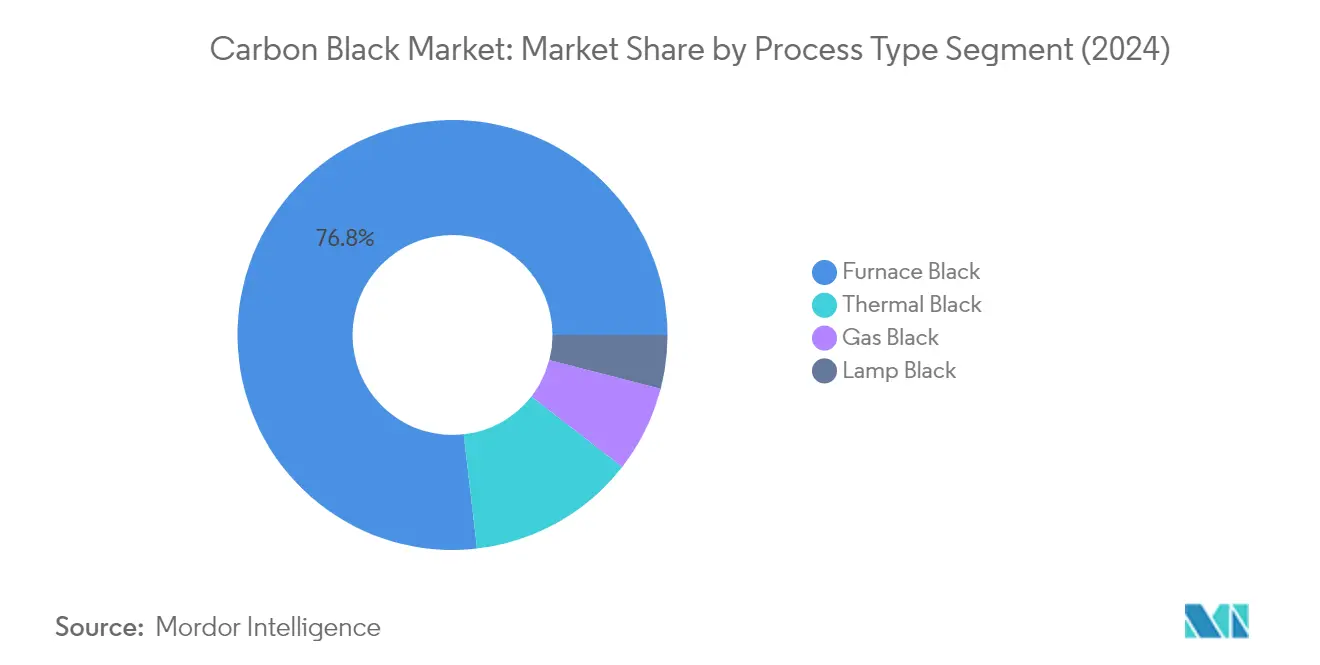
Lamp Black Segment in Carbon Black Market
The Lamp Black segment is projected to experience the highest growth rate in the carbon black market during the forecast period 2024-2029, with an expected growth rate of approximately 8%. This growth is driven by its unique properties and increasing applications in specialized industries. Lamp Black, being the oldest and most primitive carbon black process, offers distinct advantages in producing carbon black with specific color properties, making it particularly valuable for ink stick production. The segment's growth is further supported by its expanding applications in paints as a tinting pigment, especially where a blue tone is desired. The soft brownish or bluish-black pigment produced through this process demonstrates exceptional stability and resistance to light, acids, and alkalis, making it increasingly popular in premium applications such as printer ink, black shoe polish, typewriter ribbons, and specialized black paints.
Remaining Segments in Process Type
The Gas Black and Thermal Black segments complete the carbon black market's process type portfolio, each serving distinct industrial applications. Gas Black, utilizing vaporized oil instead of natural gas as feedstock, is particularly valued in the industry for its flexible structure and great dispersibility, making it ideal for pigment carbon black applications. The segment has maintained its significance in specialized applications despite losing prominence in reinforcing applications. Meanwhile, Thermal Black, characterized by its largest particle size and smallest surface area among carbon blacks, serves crucial applications in the rubber and plastics industries. This segment is particularly valued for applications requiring low reinforcement, low modulus, hardness, and hysteresis properties, while offering high elongation and loading capacity benefits for specific industrial applications.
Segment Analysis: By Application
Tires and Industrial Rubber Products Segment in Carbon Black Market
The tires and industrial rubber products segment dominates the carbon black market, commanding approximately 75% of the total market share in 2024. This substantial market presence is primarily driven by the extensive use of carbon black in tire manufacturing, where it serves as a crucial reinforcing agent. The segment's dominance is further strengthened by the growing automotive industry in both Europe and Asia-Pacific regions, with major tire manufacturers like Bridgestone, Michelin, and Continental maintaining robust production facilities. Carbon Black's essential role in enhancing tire properties such as wear resistance, tensile strength, and durability continues to drive its demand in this segment, with more than 40 different grades currently being utilized in the rubber industry.
Toners and Printing Inks Segment in Carbon Black Market
The toners and printing inks segment is emerging as the fastest-growing application area in the carbon black market, projected to grow at approximately 8% during 2024-2029. This growth is primarily driven by the increasing demand for high-quality printing materials across various industries, particularly in packaging and commercial printing sectors. Carbon Black's superior properties as a pigment, including its high tinting strength compared to iron black or organic pigments, make it increasingly popular in newspaper inks, printing inks, and toners. The segment's growth is further supported by technological advancements in printing applications and the rising demand for specialty carbon blacks that offer enhanced dispersion and coloristic properties.
Remaining Segments in Carbon Black Market by Application
The remaining segments in the carbon black market include plastics, paints and coatings, and other applications, each serving distinct industrial needs. The plastics segment utilizes carbon black for UV protection, conductivity enhancement, and color properties in various plastic products. The paints and coatings segment leverages carbon black's properties for achieving deep black colors and enhanced durability in automotive and industrial coatings. Other applications encompass diverse uses in construction materials, power cables, and insulation industries, where carbon black's unique properties contribute to product performance and functionality. These segments collectively demonstrate the versatility of carbon black across different industrial applications.
Carbon Black Market Geography Segment Analysis
Carbon Black Market in Europe
The European carbon black market demonstrates a complex landscape with significant variations across different countries. Germany leads the regional carbon black market, followed by France and Russia, while the United Kingdom and Nordic countries contribute substantially to the overall market dynamics. The market is primarily driven by the robust automotive and tire manufacturing sectors, particularly in Germany and France. The region's strong focus on sustainable practices and environmental regulations has led to increased investments in recovered carbon black technologies and eco-friendly manufacturing processes.
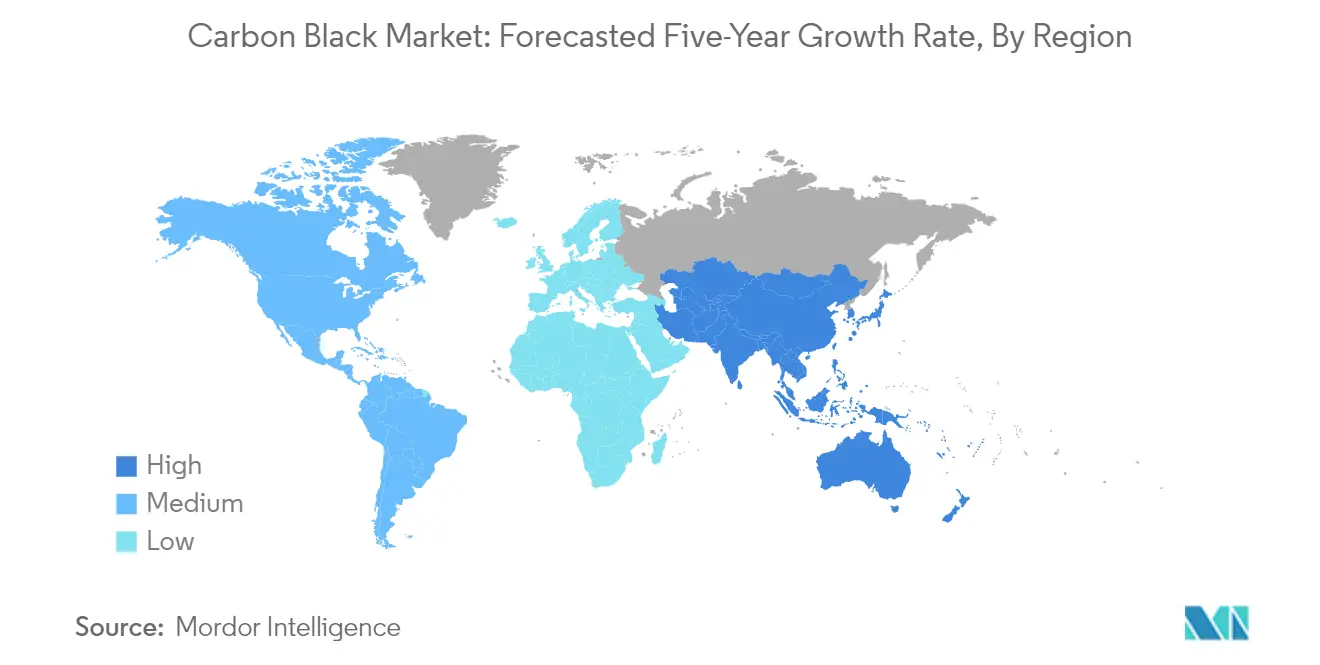
Carbon Black Market in Germany
Germany maintains its position as the dominant force in the European carbon black market, supported by its well-established automotive industry and strong manufacturing base. The country hosts several major tire manufacturers and automotive OEMs, driving consistent demand for carbon black products. With approximately 36% share of Europe's carbon black market in 2024, Germany's market leadership is reinforced by the presence of key industry players and continuous technological advancements in carbon black applications. The country's robust industrial rubber goods sector and growing emphasis on specialty carbon black applications further strengthen its market position.
Carbon Black Market in United Kingdom
The United Kingdom emerges as the fastest-growing market in Europe, with a projected growth rate of approximately 7% during 2024-2029. The country's market expansion is driven by increasing investments in sustainable manufacturing practices and growing demand from various end-use industries. The UK's focus on innovative applications in the rubber and plastics sectors, combined with rising demand for specialty carbon black in high-performance applications, contributes to its rapid growth. The country's strategic initiatives in electric vehicle manufacturing and tire production facilities further accelerate market development.
Carbon Black Market in Asia-Pacific
The Asia-Pacific region represents the largest and most dynamic carbon black market globally, with China leading the regional landscape, followed by India and Japan. The region's market is characterized by rapid industrialization, an expanding automotive sector, and growing manufacturing activities across various end-use industries. The presence of major tire manufacturers, a robust rubber industry, and increasing investments in production capacities significantly influence carbon black market growth patterns across different countries.
Carbon Black Market in China
China dominates the Asia-Pacific carbon black market, commanding approximately 54% of the regional market share in 2024. The country's market leadership is supported by its massive tire manufacturing industry, extensive rubber products sector, and growing automotive production capabilities. China's strategic focus on expanding its carbon black production capacity, coupled with significant investments in research and development, reinforces its position as the regional powerhouse. The country's robust supply chain network and presence of major industry players contribute to its market dominance.
Carbon Black Market in India
India positions itself as the fastest-growing market in the Asia-Pacific region, with an expected growth rate of approximately 7% during 2024-2029. The country's market expansion is driven by rapid industrialization, increasing automotive production, and growing demand from the tire manufacturing sector. India's strategic initiatives to boost domestic manufacturing capabilities, coupled with rising investments in carbon black production facilities, contribute to its accelerated growth trajectory. The country's evolving market dynamics and favorable government policies supporting industrial growth further enhance its market development.
Carbon Black Industry Overview
Top Companies in Carbon Black Market
The carbon black market is characterized by intense competition among established players who are continuously investing in product innovation and technological advancement. Carbon black companies are focusing on developing specialty grades of carbon black to cater to emerging applications in batteries, electronics, and sustainable materials. Operational excellence is being pursued through backward integration of raw material supply chains and optimization of manufacturing processes. Strategic initiatives include capacity expansions, particularly in high-growth regions like India and China, alongside investments in sustainable production methods and recovered carbon black technologies. Market leaders are strengthening their positions through acquisitions and collaborations, while also emphasizing research and development to meet evolving customer requirements for higher performance and environmentally friendly products.
Consolidated Market with Strong Regional Players
The carbon black market exhibits a partially fragmented structure with a mix of global conglomerates and regional specialists competing across different geographies. Major multinational players like Cabot Corporation and Birla Carbon maintain dominant positions through their extensive production networks and comprehensive product portfolios, while regional players leverage their local market knowledge and customer relationships. The market has witnessed significant consolidation through strategic acquisitions, particularly in Asia-Pacific and Europe, as companies seek to expand their geographical presence and technological capabilities.
The competitive dynamics are shaped by the presence of vertically integrated manufacturers who benefit from secured raw material supply and enhanced cost competitiveness. Merger and acquisition activities are primarily driven by the need to acquire specialized technologies, enter new markets, and achieve economies of scale. Companies are increasingly focusing on establishing manufacturing facilities in strategic locations to better serve key end-user industries and optimize logistics costs, while also investing in joint ventures to share technological expertise and market access.
Innovation and Sustainability Drive Future Success
Success in the carbon black industry increasingly depends on companies' ability to develop innovative products while maintaining cost competitiveness and environmental sustainability. Incumbent players are focusing on expanding their specialty black portfolios, investing in sustainable production technologies, and strengthening their distribution networks to maintain market leadership. The ability to offer customized solutions for specific applications, particularly in emerging sectors like electric vehicles and renewable energy, while maintaining strong relationships with key customers in traditional sectors like tire manufacturing, will be crucial for market success.
New entrants and challenger companies can gain carbon black market share by focusing on niche applications, developing innovative technologies for sustainable production, and establishing strong regional presence in high-growth markets. The industry faces increasing regulatory pressure regarding environmental compliance and carbon emissions, making investments in clean technologies and circular economy solutions essential for long-term success. Companies must also address the concentration risk in key end-user industries through diversification strategies and development of new applications, while maintaining flexibility to adapt to changing market conditions and customer requirements.
Carbon Black Market Leaders
-
Cabot Corporation
-
Birla Carbon (Aditya Birla Group)
-
Orion Engineered Carbons SA
-
Jiangxi HEIMAO Carbon black Co. Ltd
-
International CSRC Investment Holdings Co., Ltd.
- *Disclaimer: Major Players sorted in no particular order
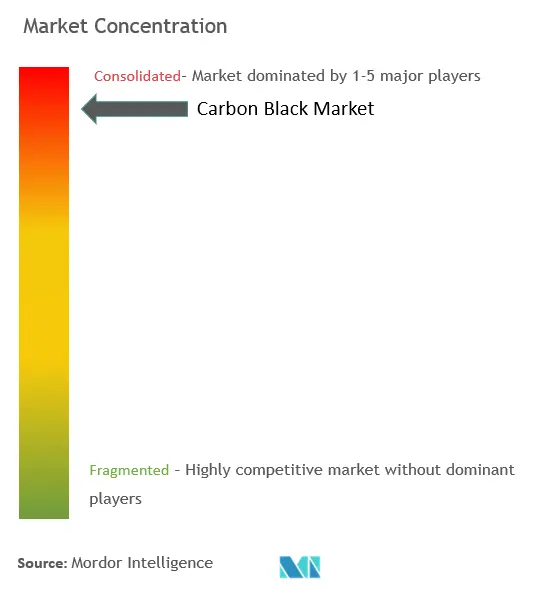
Carbon Black Market News
- June 2023: PCBL Limited initiated two growth projects which incorporate the new plant expansion in Chennai, Tamil Nadu, and an existing plant project at Mundra, Gujarat. This expansion is divided into two stages, and the first stage of the specialty chemical line is expected to be put into operation by the first quarter of the fiscal year 2023-24. As a result, the overall manufacturing capacity of the company is estimated to reach 790,000 MTPA and 122 MW of renewable energy.
- February 2023: Balkrishna Industries Ltd (BKT) intensified its carbon black production activities and plans to increase capacity by almost 20% this year. The company will expand its Bhuj plant in the eastern Indian state of Gujarat to produce 198 kilotons per year. The Bhuj plant started operations in 2017 and has the capacity to produce 65 ktpa of carbon black grades for tire tread applications.
- In June 2022, ADNOC Distribution entered a new carbon black supply agreement with ADNOC, which will enable ADNOC Distribution to test the market for carbon black.
Carbon Black Market Report - Table of Contents
1. INTRODUCTION
- 1.1 Study Assumptions
- 1.2 Scope of the Study
2. RESEARCH METHODOLOGY
3. EXECUTIVE SUMMARY
4. MARKET DYNAMICS
-
4.1 Drivers
- 4.1.1 Increasing Market Penetration of Specialty Black
- 4.1.2 Growing Applications in the Batteries Segment
-
4.2 Restraints
- 4.2.1 Increasing Investments for Recovered Carbon Black
- 4.2.2 Volatility in Prices of Raw Materials
- 4.3 Industry Value Chain Analysis
-
4.4 Porter's Five Forces Analysis
- 4.4.1 Bargaining Power of Suppliers
- 4.4.2 Bargaining Power of Buyers
- 4.4.3 Threat of New Entrants
- 4.4.4 Threat of Substitute Products and Services
- 4.4.5 Degree of Competition
- 4.5 Trade Analysis
- 4.6 Technology Landscape - Quick Snapshot
- 4.7 Production Analysis
- 4.8 Price Trend Analysis
5. MARKET SEGMENTATION (Market Size in Volume and Value)
-
5.1 Process Type
- 5.1.1 Furnace Black
- 5.1.2 Gas Black
- 5.1.3 Lamp Black
- 5.1.4 Thermal Black
-
5.2 Application
- 5.2.1 Tires and Industrial Rubber Products
- 5.2.2 Plastic
- 5.2.3 Toners and Printing Inks
- 5.2.4 Coatings
- 5.2.5 Textile Fiber
- 5.2.6 Other Applications
-
5.3 Geography
- 5.3.1 Asia-Pacific
- 5.3.1.1 China
- 5.3.1.2 India
- 5.3.1.3 Japan
- 5.3.1.4 South Korea
- 5.3.1.5 Rest of Asia-Pacific
- 5.3.2 North America
- 5.3.2.1 United States
- 5.3.2.2 Canada
- 5.3.2.3 Mexico
- 5.3.3 Europe
- 5.3.3.1 Germany
- 5.3.3.2 United Kingdom
- 5.3.3.3 Italy
- 5.3.3.4 France
- 5.3.3.5 Rest of Europe
- 5.3.4 South America
- 5.3.4.1 Brazil
- 5.3.4.2 Argentina
- 5.3.4.3 Rest of South America
- 5.3.5 Middle East and Africa
- 5.3.5.1 Saudi Arabia
- 5.3.5.2 South Africa
- 5.3.5.3 United Arab Emirates
- 5.3.5.4 Rest of Middle East and Africa
6. COMPETITIVE LANDSCAPE
- 6.1 Mergers, Acquisitions, Joint Ventures, Collaborations, and Agreements
- 6.2 Market Share (%) Analysis
- 6.3 Strategies Adopted by Leading Players
-
6.4 Company Profiles
- 6.4.1 ADNOC Group
- 6.4.2 Asahi Carbon Co. Ltd
- 6.4.3 Birla Carbon (Aditya Birla Group)
- 6.4.4 BKT Carbon
- 6.4.5 Cabot Corporation
- 6.4.6 Epsilon Carbon Private Limited
- 6.4.7 Himadri Speciality Chemical Ltd
- 6.4.8 Imerys SA
- 6.4.9 International CSRC Investment Holdings Co. Ltd
- 6.4.10 Jiangxi Heimao Carbon Black Co. Ltd
- 6.4.11 Longxing Chemical Stock Co. Ltd
- 6.4.12 Mitsubishi Chemical Corporation
- 6.4.13 NNPC Limited
- 6.4.14 OCI Company Ltd
- 6.4.15 Omsk Carbon Group
- 6.4.16 Orion Engineered Carbons SA
- 6.4.17 PCBL Limited
- 6.4.18 Tokai Carbon Co. Ltd
- *List Not Exhaustive
7. MARKET OPPORTUNITIES AND FUTURE TRENDS
- 7.1 Growth in the Adoption of Electric Cars
Carbon Black Industry Segmentation
Carbon black is a fine carbon powder made by incomplete combustion or thermal decomposition of gaseous or liquid hydrocarbons under controlled conditions. The carbon black market is segmented by process type, application, and geography. By process type, the market is segmented into furnace black, gas black, lamp black, and thermal black. By application, the market is segmented into tires and industrial rubber products, plastics, toners and printing inks, coatings, textile fibers, and other applications. The report also covers the market size and forecasts for the carbon black market in 16 countries across major regions. The report offers the volume in kiloton and market size in value terms in USD for all the abovementioned segments.
| Process Type | Furnace Black | ||
| Gas Black | |||
| Lamp Black | |||
| Thermal Black | |||
| Application | Tires and Industrial Rubber Products | ||
| Plastic | |||
| Toners and Printing Inks | |||
| Coatings | |||
| Textile Fiber | |||
| Other Applications | |||
| Geography | Asia-Pacific | China | |
| India | |||
| Japan | |||
| South Korea | |||
| Rest of Asia-Pacific | |||
| North America | United States | ||
| Canada | |||
| Mexico | |||
| Europe | Germany | ||
| United Kingdom | |||
| Italy | |||
| France | |||
| Rest of Europe | |||
| South America | Brazil | ||
| Argentina | |||
| Rest of South America | |||
| Middle East and Africa | Saudi Arabia | ||
| South Africa | |||
| United Arab Emirates | |||
| Rest of Middle East and Africa | |||
Carbon Black Market Research FAQs
How big is the Carbon Black Market?
The Carbon Black Market size is expected to reach USD 24.10 billion in 2025 and grow at a CAGR of 5.75% to reach USD 31.87 billion by 2030.
What is the current Carbon Black Market size?
In 2025, the Carbon Black Market size is expected to reach USD 24.10 billion.
Who are the key players in Carbon Black Market?
Cabot Corporation, Birla Carbon (Aditya Birla Group), Orion Engineered Carbons SA, Jiangxi HEIMAO Carbon black Co. Ltd and International CSRC Investment Holdings Co., Ltd. are the major companies operating in the Carbon Black Market.
Which is the fastest growing region in Carbon Black Market?
Asia-Pacific is estimated to grow at the highest CAGR over the forecast period (2025-2030).
Which region has the biggest share in Carbon Black Market?
In 2025, the Asia Pacific accounts for the largest market share in Carbon Black Market.
What years does this Carbon Black Market cover, and what was the market size in 2024?
In 2024, the Carbon Black Market size was estimated at USD 22.71 billion. The report covers the Carbon Black Market historical market size for years: 2019, 2020, 2021, 2022, 2023 and 2024. The report also forecasts the Carbon Black Market size for years: 2025, 2026, 2027, 2028, 2029 and 2030.
Our Best Selling Reports
Carbon Black Market Research
Mordor Intelligence provides a comprehensive analysis of the carbon black industry, drawing on decades of expertise in chemical market research. Our extensive coverage includes all major product types such as furnace black, acetylene black, thermal black, lamp black, and channel black. These are examined alongside their applications across various sectors. The report offers detailed insights into carbon black companies and their strategic positioning. It analyzes applications ranging from tire carbon black and rubber carbon black to conductive carbon black and ink carbon black.
Our detailed carbon black market analysis and industry outlook provide stakeholders with valuable insights into price trend dynamics and future market potential. This information is available in an easy-to-read report PDF format for download. The report covers crucial segments, including automotive carbon black and specialty carbon black, offering comprehensive market forecast data and industry trends. Stakeholders benefit from our thorough examination of pigment carbon black applications and emerging opportunities in the carbon black industry. This is supported by robust market research methodologies and expert analysis of global supply-demand scenarios.




